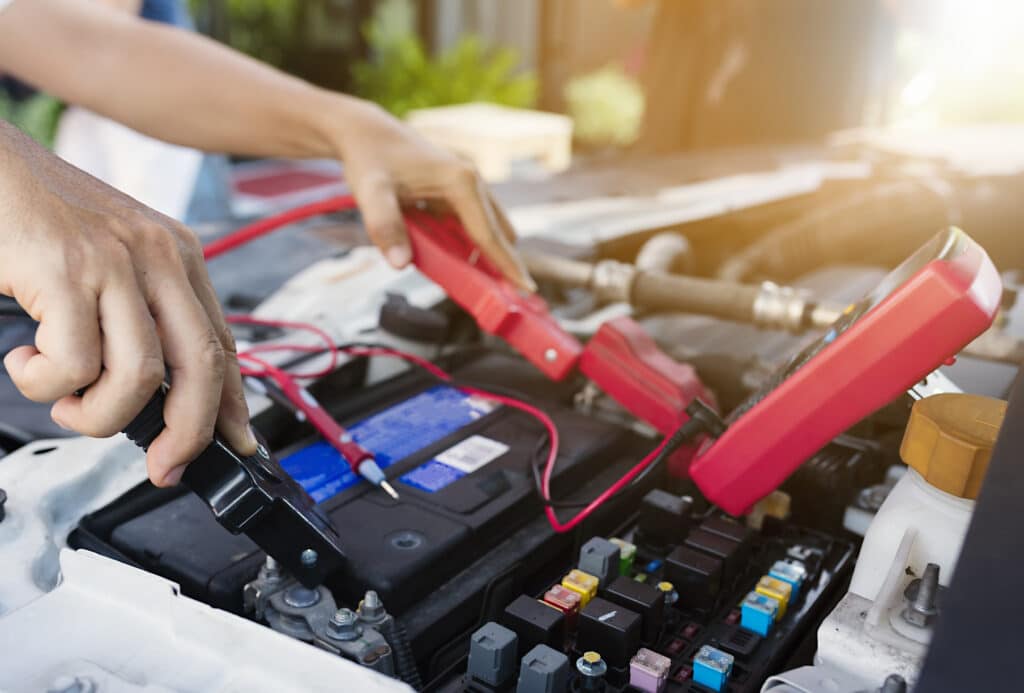Do you ever feel like car battery specifications are written in a foreign language? You’re not alone.
In this blog post, we’ll explain all the different car battery specifications with pictures to help you understand what they mean. By the end of this post, you’ll be an expert on car batteries!
Here’s what this article covers,
Table of Contents
A glossary of car battery specs
An example of a car battery label
Acid
In car batteries, acid or battery fluid is a mixture of sulfuric acid and distilled water (called electrolytes) that can release hydrogen ions, creating electricity.
Why do I need to know this? Battery fluid need to be checked from time to time. But, most batteries nowadays are Maintenance-Free so topping up is not super necessary.
Related: How to check if your car battery needs replacing
AGM (Absorbent Glass Mat)
AGM batteries feature an innovative separator powered by glass microfibers, allowing the electrolyte to be suspended in a dry state.
This means no maintenance and greater safety – so you can enjoy worry-free battery power!
Ampere (Amp, A)
Amps are the unit of measure for the rate at which electrons, or an electrical current, flows through a circuit.
Ampere-Hour (Amp-Hrs, Ah)
A battery’s power potential is measured by its amp-houres (Ah).
The higher the Ah, the more charge it can store and thus provide a longer life.
To calculate an individual battery’s capacity in terms of Ah, multiply amps with hours of discharge – for example 5A x 20h = 100Ah!
Cold Cranking Amps (CCA)
Cold Cranking Amps is a rating used to define a battery’s ability to start an engine in cold temperatures.
This is because a great amount of amps is required to start an engine in the cold, albeit only for a short burst.
Simply put, the higher the CCA, the greater the starting power of the battery.
Cycle
A battery cycle is a single discharge and recharge of your battery (not car) ‘s power.
Deep Cycle battery
Regular cars have ” lead-acid” batteries, which create electricity in shorter bursts. Deep cycle batteries are different; they produce ongoing, lower yet consistent, levels of power.
This electricity is enough to power vehicles without a motor such as recreational vehicles, boats, and golf carts.
Detailed Guide: What is a deep cycle battery?
Discharging
Discharging is when a battery is in use, or delivering a current. Some batteries may be deeply discharged – which means a low current is being drawn from the battery.
In a deep discharge, the actual voltage will fall below the final discharging voltage.
Electrolyte
Electrolyte is a conductor that enables an electrochemical reaction, thereby generating electricity. In a lead-acid battery, the electrolyte is sulfuric acid diluted with water.
Gel
Gel batteries contain an electrolyte that has been immobilised using a chemical like fine silica. This is to prevent spillage, in lieu of an AGM.
Lead-acid battery
Lead-acid batteries are one of the most widely used types of battery for cars.
They use a combination of lead plates and sulfuric acid.
Related: What is a battery and how does it work?
Marine Cranking Amps (MCA)
MCA serves the same purpose for marine batteries as the CCA does for car batteries.
While CCA is measured at -17.8°C, MCA is measured at 0°C. This is because marine batteries are typically never used at temperatures below freezing.
Just like CCA, MCA is an indication of the starting power of a battery.
Maintenance-free
A maintenance-free battery generally requires no service watering (topping up electrolyte levels) during its lifetime.
Open-circuit voltage
Open circuit voltage is the voltage of a battery when it is neither delivering nor receiving power. Essentially, it is the “idle” voltage.
Reserve capacity rating (RC)
This rating represents the time a battery will continue to operate essential accessories if the alternator in your car fails.
Your alternator will typically convert chemical energy into electric energy to replenish your car’s battery as your drive.
However, if this fails, the battery will continue providing a current until its reserve capacity has run out.
The RC is represented in minutes and is only indicative for a new, fully charged battery delivering 25 amps at 27°C.
Starting, Lighting, Ignition (SLI) Battery
Also called a starting battery, an SLI is your standard rechargeable battery for a passenger vehicle.
It supplies electricity in a large short burst to power the motor, lights and ignition system of your car before the alternator kicks in to replenish what was discharged.
Volt
A volt is the unit of measure for electrical potential. If electricity were water in a pipe, imagine volts as the water pressure.
VRLA
VRLA stands for valve-regulated lead-acid battery. These batteries don’t have free liquid electrolytes.
They feature one-way burp valves that permit gas to vent from the cell as necessary while maintaining a slight pressure within the battery required to facilitate chemical reactions.
Watt
A watt is the unit for measuring electrical power, or the rate of doing work. Watts can be calculated by multiplying amps by volts.
Watt-Hour (Watt-Hrs, WH)
A watt-hour is a unit of measure for electrical energy, very simply expressed as watts multiplied by hours. While watts measure the amount of power provided at a moment in time, watt-hours are used to express the amount of energy used over a period of time.
Need help finding a new car battery?
Get more help with understanding car battery terminology. We’re more than happy to help you find the best and most suitable battery for your budget and requirements.
Holler for a Marshall on 1300 627 742 or contact us online for a new battery quote.



